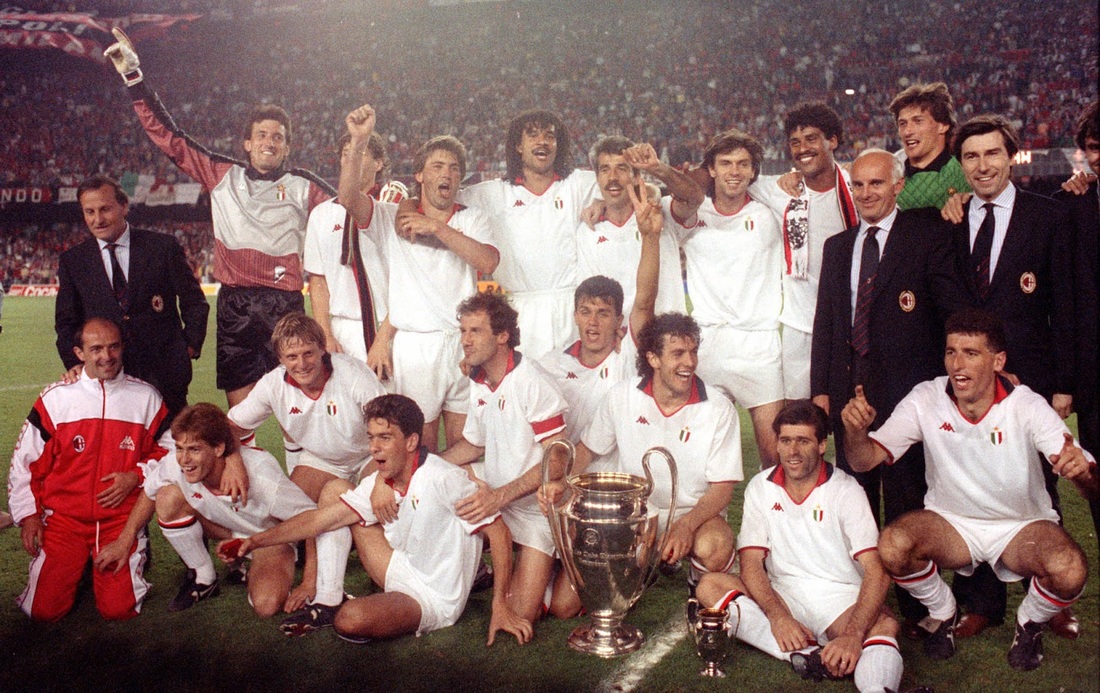The arrival of media tycoon and future Italian Prime Minister, Silvio Berlusconi, in 1986 signalled the harbinger of a new era for AC Milan, one which saw them become behemoths of European football.
Arrigo Sacchi’s arrival at Milan in 1987 was greeted with widespread scepticism in the Italian press. Despite a successful spell coaching Parma in Serie C and Serie B, many felt Sacchi would be out of his depth at such a high profile club, especially given the fact it was his first experience of coaching in Serie A.
Yet Sacchi’s debut season was an unprecedented success after Milan won their first Scudetto in almost a decade. Just two years later the Rossoneri were conquering Europe, but when Sacchi left the club at the turn of the decade, many questioned whether Milan could continue to ride this wave of success? The answer was a resounding yes. Milan won 16 trophies in the space of just seven years from 1987 to 1994; a feat that would see them nicknamed ‘The Immortals’.
If every football team had a magnum opus, the Rossoneri side of the late 1980s would unquestionably be Milan’s. Gifted with a plethora of talent, they combined Italian defensive guile with Dutch attacking ingenuity. From the dependable triumvirate of Franco Baresi, Alessandro Costacurta and Paolo Maldini, to the bewitching trio of Marco Van Basten, Frank Rijkaard and Ruud Gullit, this team was something special.
Under Sacchi, they played a brand of football which strayed from the traditional perception of how Italian teams played. Out with Helenio Herrera’s Catenaccio and in with Johan Cruyff’s total football. Sacchi’s obsession with this high tempo, entertaining brand of football rubbed off on his side. Being able to rely on the competence of his defensive unit, who he often asked to play a high line, Sacchi’s Milan moved the ball forward through their midfield duo of Rijkaard and Carlo Ancelotti using quick short passing. If they lost the ball they would press from the front, a tactic akin to that of Borussia Dortmund’s ‘gegenpressing’ or Barcelona’s ‘counter-press’, methods which have been fruitful for both in recent years.
Milan’s 1989 European Cup final triumph epitomised the style and ethos Sacchi had instilled. In the semi-finals, the Diavolo’s 5-0 destruction of Real Madrid was as close to perfection as a performance comes. Los Blancos had no answer to Milan’s dynamism and creativity in midfield while the movement of Gullit and Van Basten left Madrid defenders chasing shadows. In the final against Steaua Bucharest, the performance was just as impressive and Sacchi’s men romped to victory once again, this time by the margin of four goals to nil.
A year later, Sacchi and Milan retained the European Cup with a 1-0 over Benfica. However after a trophy-less campaign during the 1990-91 season, and amid rumours of a rift between Sacchi and star striker Van Basten, Berlusconi made the ruthless yet shrewd decision to restore coach Fabio Capello at the helm.
Capello inherited a side which still had an embarrassing array of talent. With these players at his disposal, Capello’s Milan still played enterprising football however the side was first and foremost built upon defensive and midfield solidity. Capello’s men became indomitable domestically. In the 1991-92 season, the Diavolo went unbeaten (a run that stretched 58 games in total) and won the scudetto, finishing eight points above their nearest rivals Juventus. Van Basten reached unimaginable heights winning the capocannoniere with a remarkable 25 goals. The highlight of the season came on the last day when Milan ripped into Zdeněk Zeman’s talented Foggia side, dismantling the Satanelli 8-2.
The following year saw the likes of Zvonomir Boban, Dejan Savicevic and Jean-Pierre Papin added to the ranks, spurring the Rossoneri to a further two Serie A titles in 1992-93 and 1993-94. This exultant era culminated in the Champions League final of 1994. Awaiting Milan were a highly fancied Barcelona side coached by Johan Cruyff. Everyone wrote the Italians off, especially given the absence of Baresi, Costacurta, Van Basten and Papin. Yet after Cruyff launched a scathing and imprudent attack on Milan’s ‘boring’ and ‘defensive’ style, Capello’s men put Barcelona to the sword winning 4-0 in Athens. Savicevic’s nonchalant lobbed goal was the icing on a very large cake.
Although ‘The Immortals’ of AC Milan will always be remembered for their dreamy Dutch trio, my father (a lifelong Rossonero) is quick to point out that some world-class Italian defending by cult hero’s Baresi, Costacurta and Maldini was integral to this golden era.

